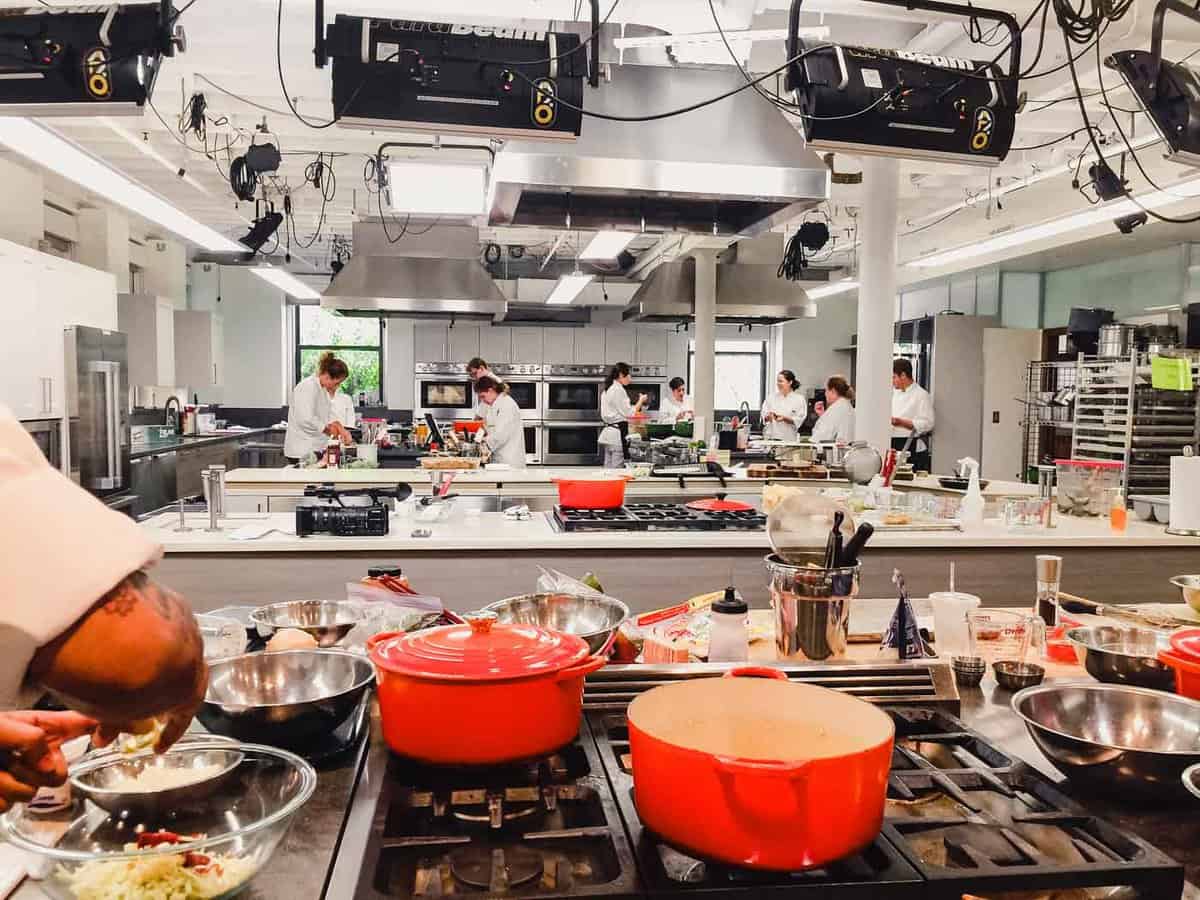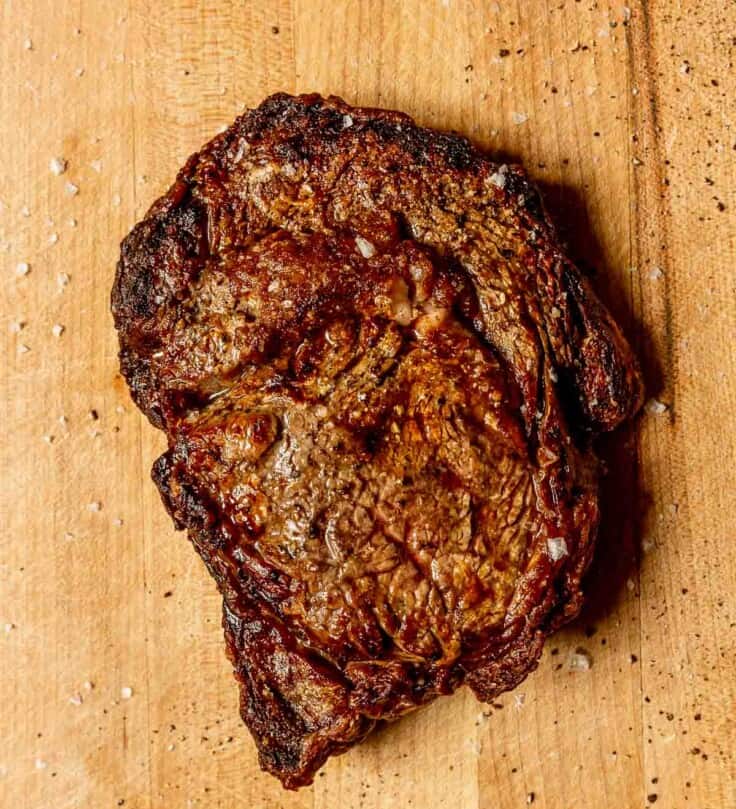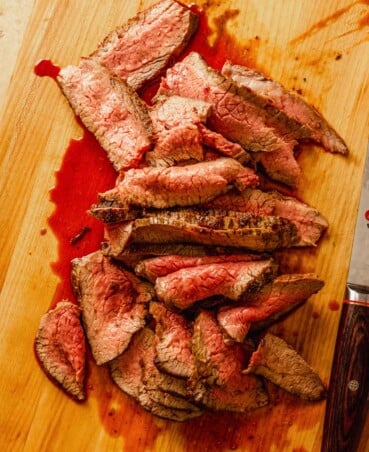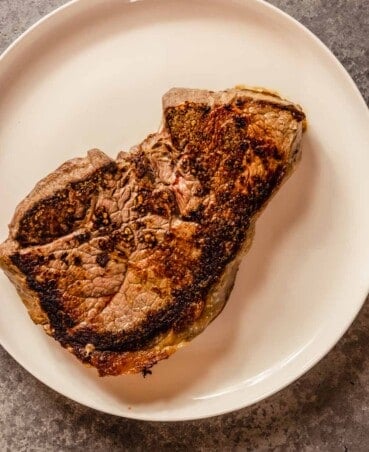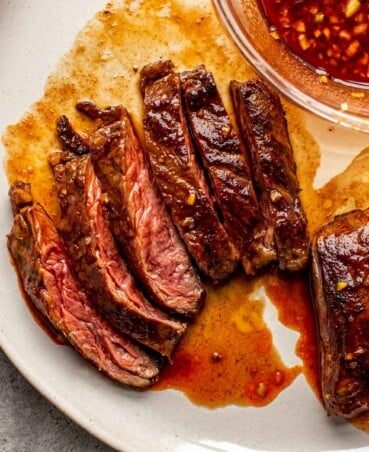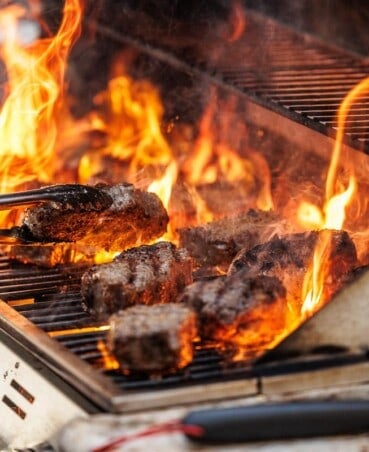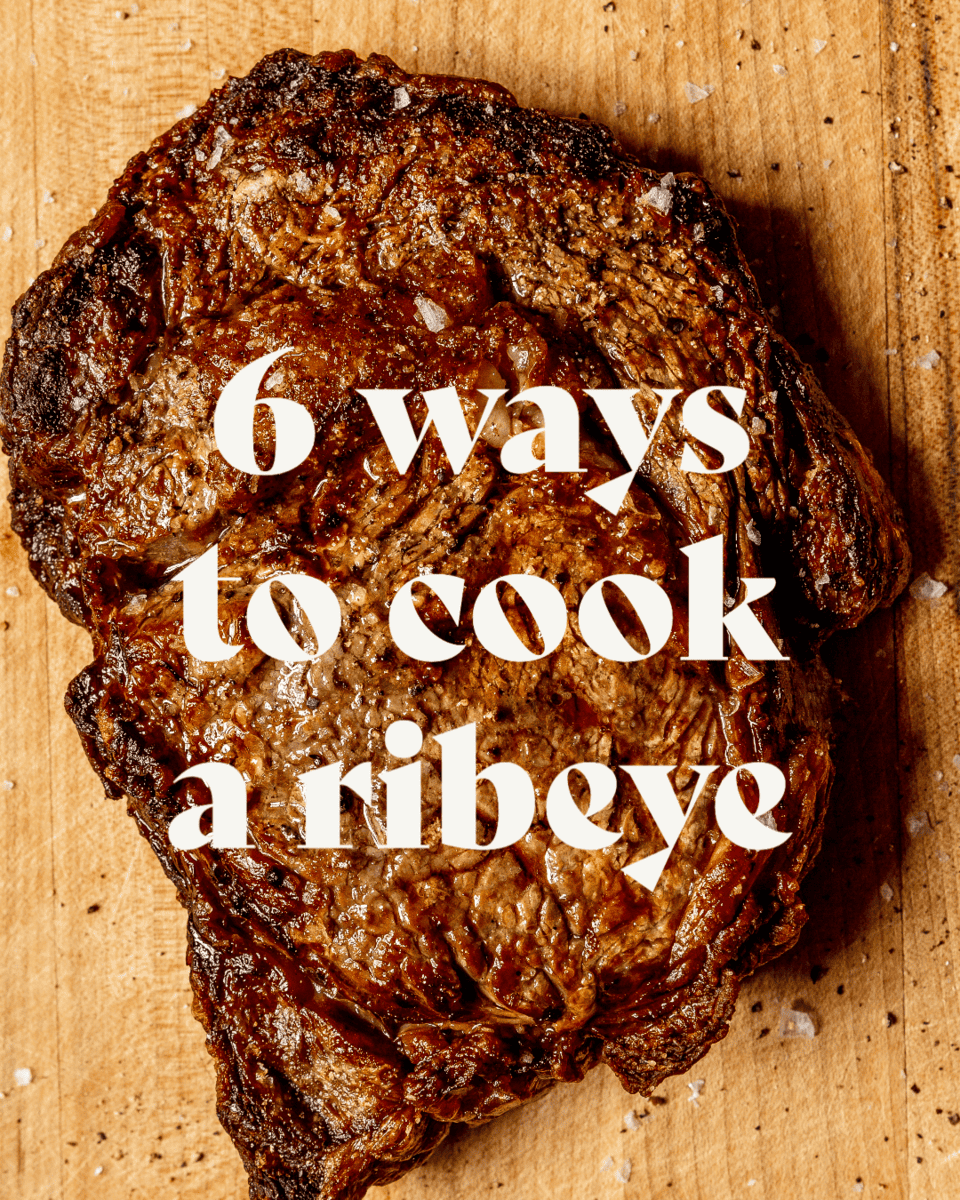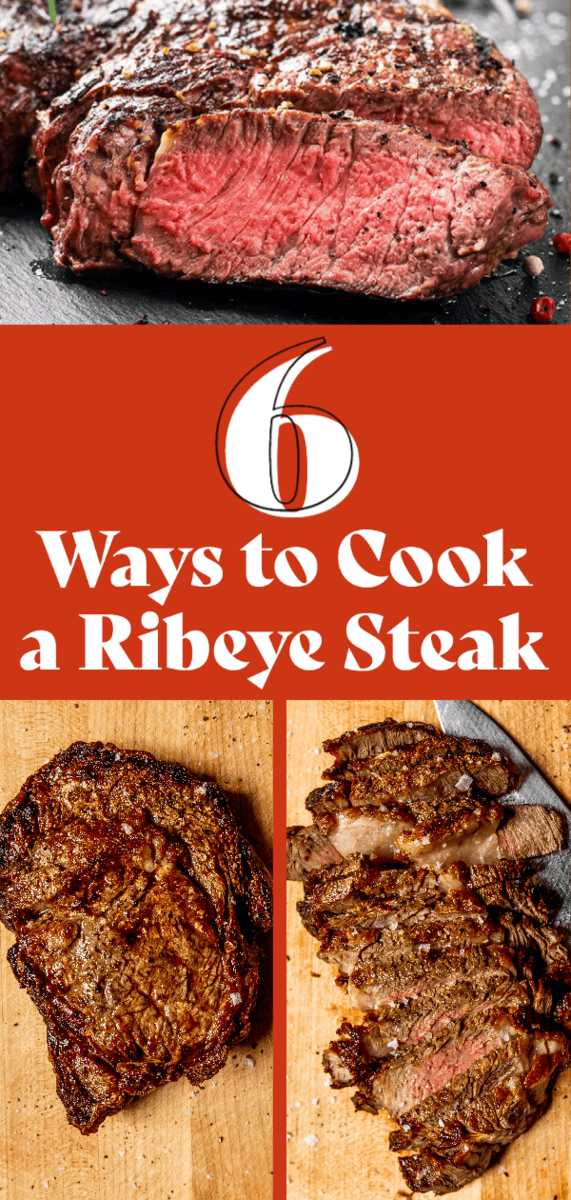A thick ribeye steak is one of the most flavorful and decadent steaks you can cook. It can also be a bit intimidating. Which is why we’ve put together the ultimate guide for cooking the perfect ribeye steak! Whether you’re grilling, pan-searing, reverse searing, roasting, air frying, or using the sous vide—we’ve got all the information you need!
Ribeye Steak
Ribeye steak comes from the rib section of the cow (same area that the prime rib comes from) and is a rich, juicy, tender and flavorful cut. It has generous marbling and can be found sold bone-in or boneless.
Since ribeyes are so rich and tender, they don’t require long cooking times to tenderize their meat, making them the ideal candidate for quick, high-heat cooking methods such as grilling, pan-searing, and broiling. These high-heat cook methods also allow you to achieve a crisp, golden crust and perfect medium-rare interior.
When purchasing ribeye steaks, look for steaks that are between 1 and 2 inches thick with nice even marbling and a few large fat pockets.
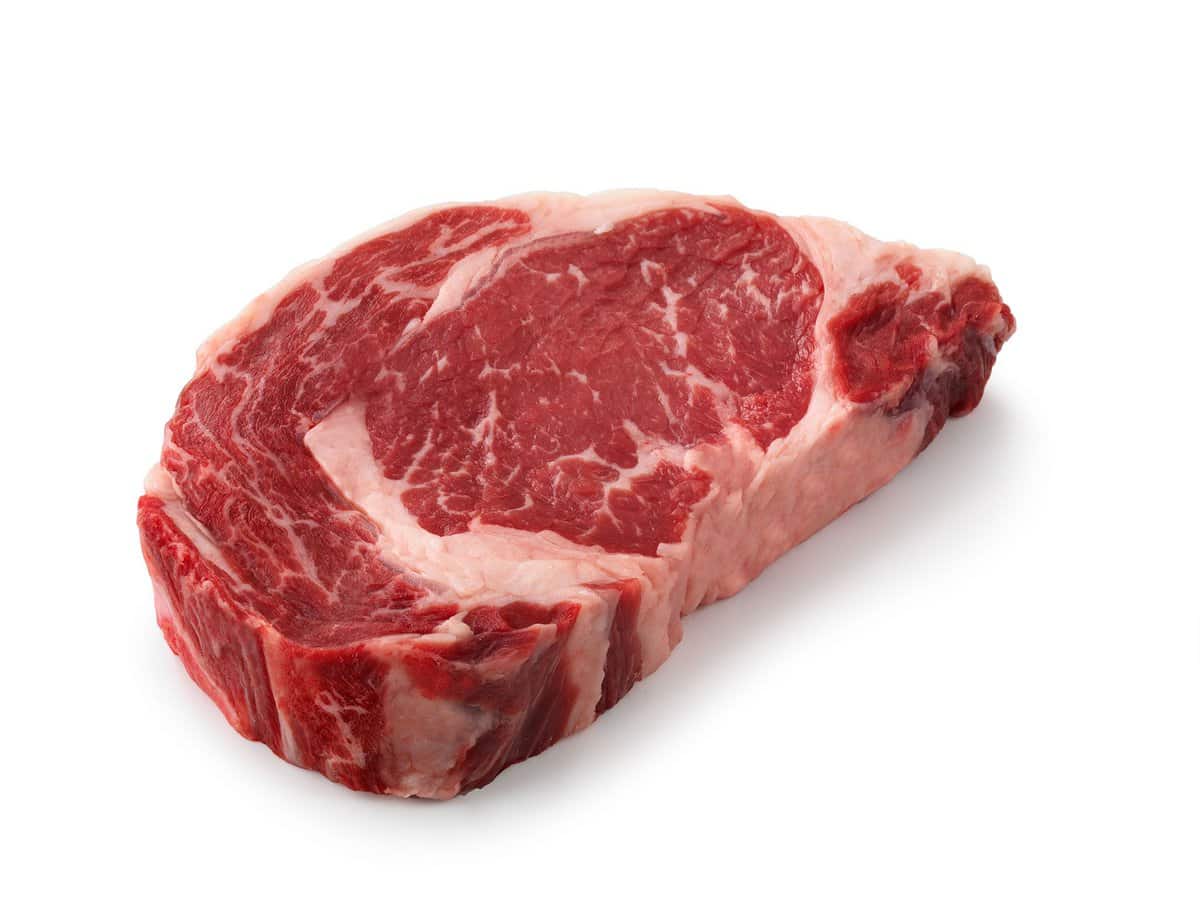
How to Cook Ribeye Steak on the Grill
- Turn all burners to high, cover, and let grill preheat for about 15 minutes. Brush grill grate clean.
- Pat steak dry with paper towels, then season with 1 teaspoon salt and ½ teaspoon pepper.
- When ready to cook, keep primary burner on high and turn other burners off.
- Place steak over hot part of grill and cook until beginning to char and beads of moisture appear on edges of steak, 5–6 minutes. Flip steak and continue to cook until an instant-read thermometer inserted in the center registers 125ºF for medium-rare, about 5 minutes.
- Transfer steak to a clean plate, tent loosely with foil or parchment paper and let rest 10 minutes.
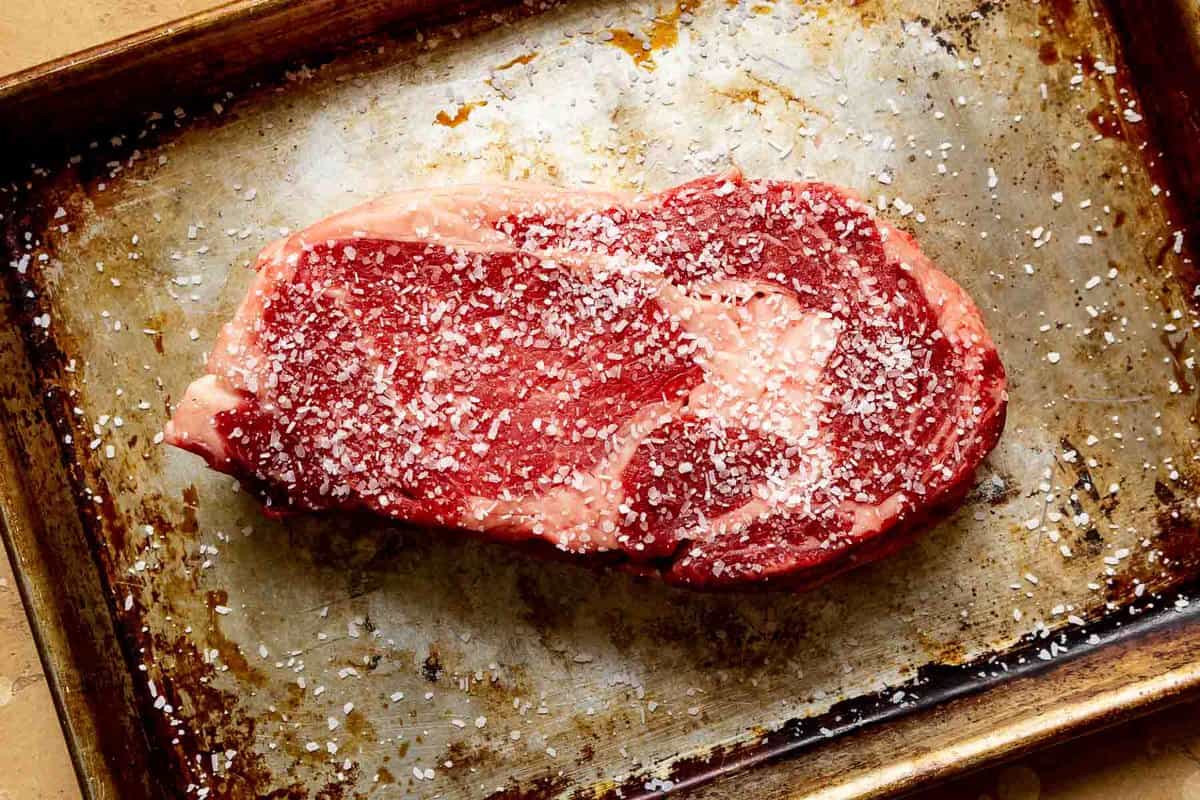
How to Cook Ribeye Steak in the Oven
For oven roasting, we like to use bone-in ribeye steaks. Though this method will also work with boneless. If you’re using boneless steaks, watch the temperature closely and don’t rely solely on the cooking time—temperature is king when cooking steaks.
- Heat oven to 250ºF with rack set in middle position. Set a wire rack inside a rimmed baking sheet. Pat steaks dry then season generously with kosher salt. Place steaks on rack and roast until an instant-read thermometer inserted into side of steak registers 90ºF–95ºF, this will take 30–50 minutes, flipping the steaks halfway through.
- Heat a generous splash of high-heat cooking oil in a large skillet over high heat until shimmering. Pat steaks dry with paper towels then gently place in skillet and cook, without moving, for 30 seconds. Flip steaks and continue to cook, flipping every 30 seconds, until lightly browned, about 3 minutes.
- Add a few tablespoons of butter to the skillet. Once melted, tilt the skillet so the butter pools; use a large spoon to spoon the butter up and over the steaks repeatedly (this is called basting). Continue to baste steaks, flipping every 30 seconds, until steaks register 120–125ºF for medium-rare, this will take 1–3 minutes.
- Transfer steaks to carving board and let rest for 10 minutes. Strain seasoned butter into small bowl; discard solids. Carve steaks off bones, then slice into ¼-inch-thick slices. Serve with seasoned butter.
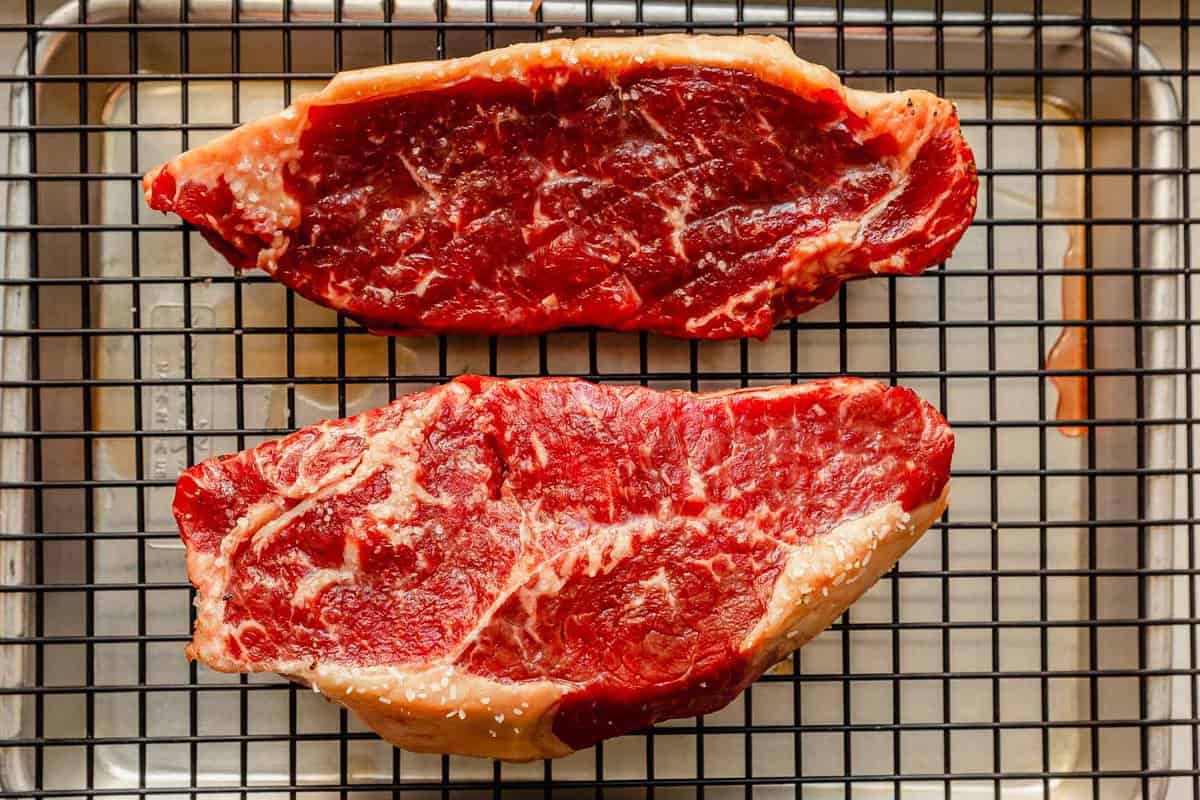
How to Cook Ribeye Steak on the Stove
- Preheat a large cast-iron skillet over high heat for 5 minutes.
- Pat steak dry with paper towels, then season with 1 teaspoon salt.
- Reduce heat to medium-high. Add a splash of vegetable oil and swirl to coat the pan. Place steak in skillet. Cook until charred and beads of moisture begin to form around edges of steak, about 3 minutes. Flip and continue cooking until an instant-read thermometer inserted in the center registers 125ºF for medium-rare, about 3 more minutes. For medium cook to an internal temperature is 135ºF, about 4 minutes per side.
- Transfer steak to a clean plate, tent loosely with foil or parchment paper and let rest 10 minutes.
How to Reverse Sear Ribeye Steak
Reverse searing steaks is one of our favorite methods for cooking steak.
Season the Steaks
- Set the steaks on a wire rack set inside a baking sheet. Season the steaks well with kosher salt.
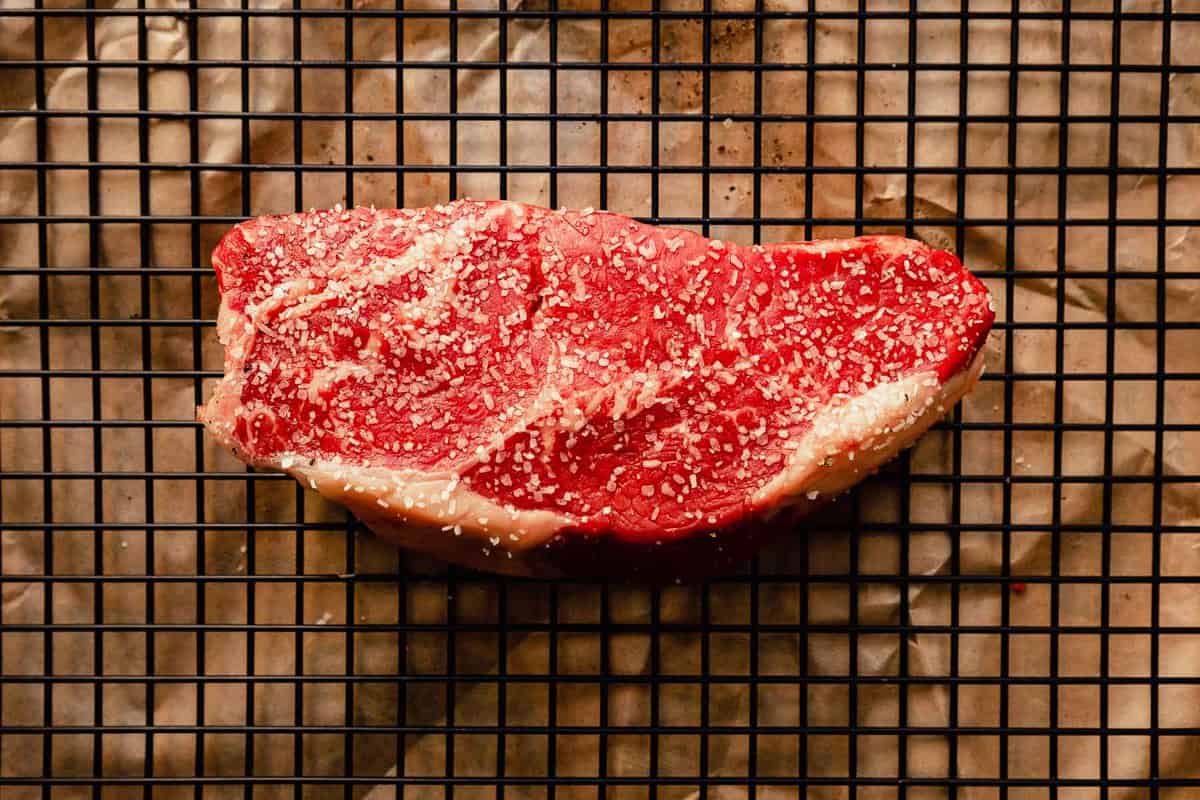
Roast the Steaks
- Heat the oven to 200ºF or as low as it will go. The lower the temperature, the longer the cook time and vice versa.
- Place steaks in the oven and cook for 15 minutes. After 15 minutes, start checking the internal temperature using an instant-read thermometer about every 5 minutes until steaks have reached:
- 100–105°F (38–41°C) for rare
- 105–115°F (41–46°C) for medium-rare
- 115–125°F (46–52°C) for medium
- 125–135°F (52–57°C) for medium-well
- 135–140ºF (57–63ºC) for well-done
This will not be the final temperature of your steak—pull it from the oven about 15 to 20 degrees (fahrenheit) under the final desired temperature.
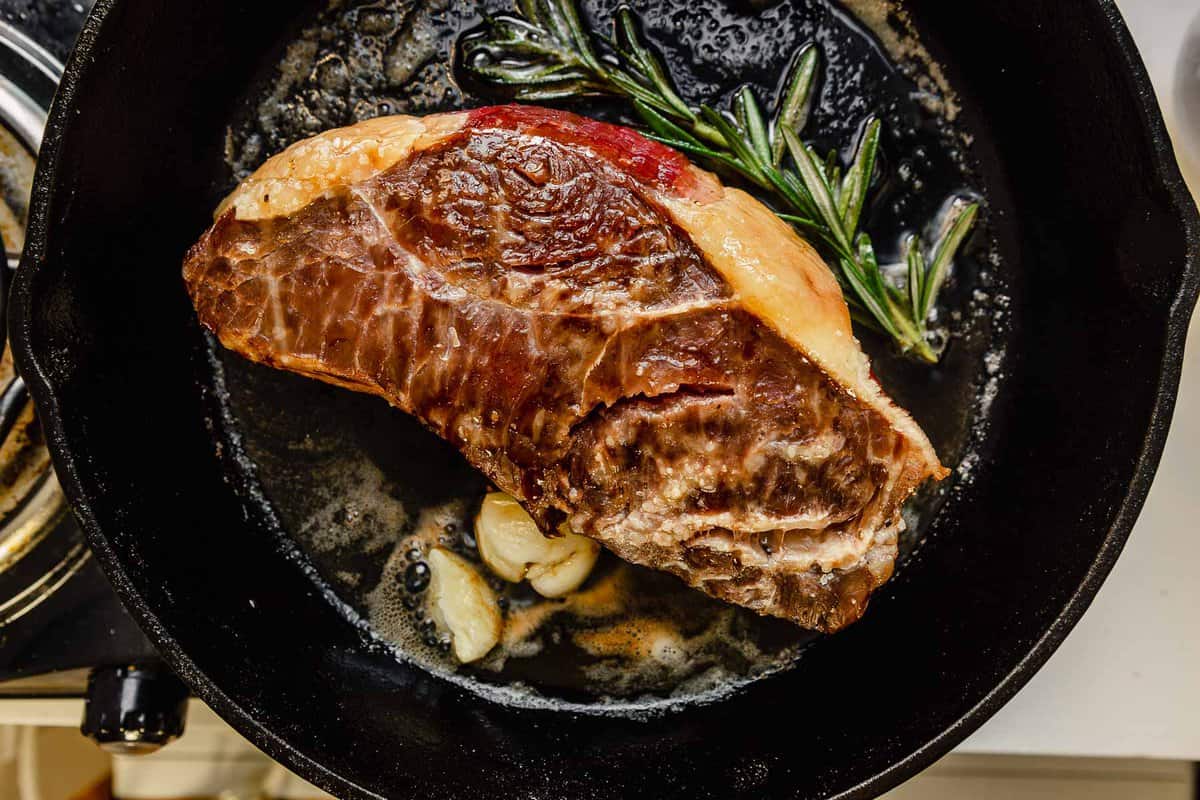
Sear Steak
- About 5 minutes before the steaks come out of the oven, start preheating a large cast-iron skillet over high.
- Once the steaks come out of the oven, add a couple tablespoons each butter and oil to the skillet and swirl to coat.
- Sear the steaks until a golden crust is formed on each side and desired doneness is reached, about 1 ½ minutes per side.
Aim for an internal temperature of:
- 120–125ºF (49–52ºC) for rare
- 125–130ºF (52–54ºC) for medium-rare
- 135–140ºF (57–60ºC) for medium
- 145–150ºF (63–65ºC) medium-well
- 155–160ºF (68–71ºC) for well-done
We should note, the USDA recommends cooking beef to a minimum internal temperature of 145ºF (63ºC).
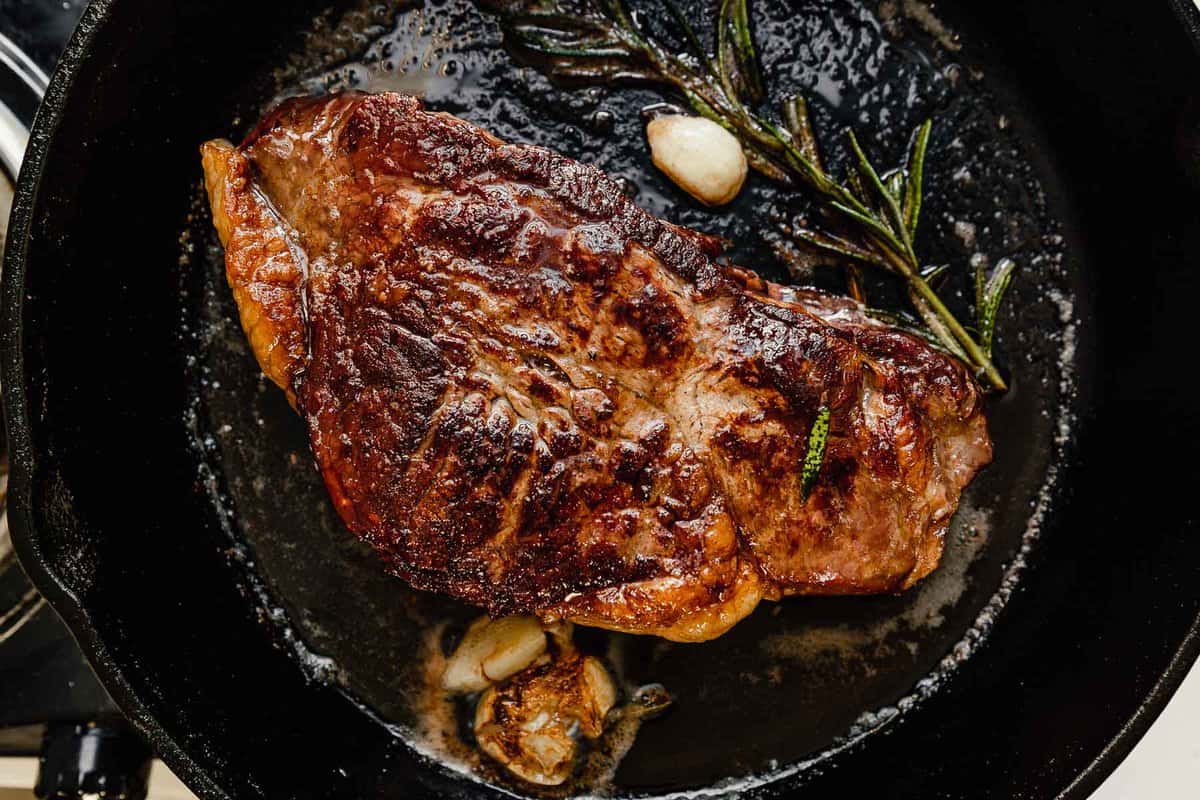
How to Cook Ribeye Steak in Air Fryer
- Preheat air fryer to 400ºF.
- Pat steak dry with paper towels then season with 1 teaspoon salt.
- Place steak in air fryer basket and cook until browned and an instant read thermometer inserted in the center registers 120–125ºF for medium-rare or 130–135ºF for medium, 8–12 minutes.
- Transfer steak to a plate and tent with foil; let rest 5 minutes.
- Slice the steak and serve as desired (we like this Blue Cheese Steak Salad).
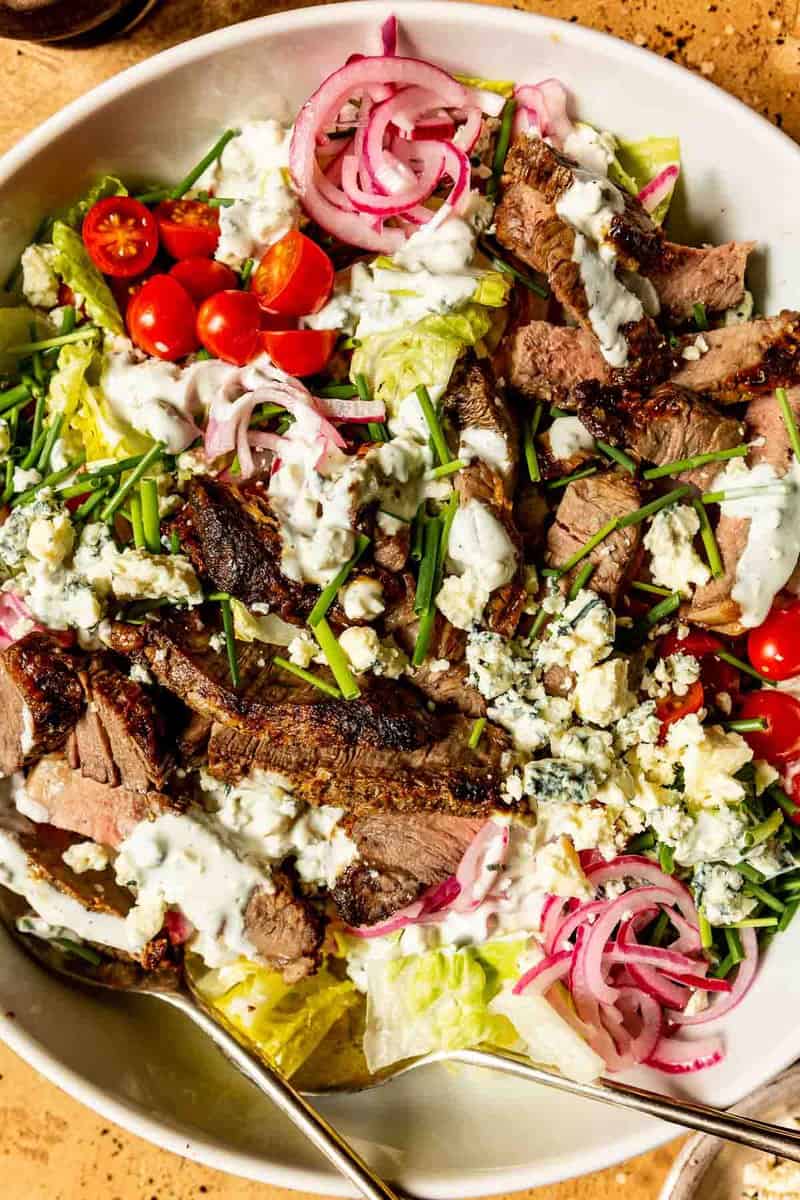
How to Sous Vide Ribeye Steak
- Preheat a sous vide cooker to desired final temperature (we like 129ºF for medium-rare).
- Place in sous vide bags along with herbs and aromatics (optional). Seal bags and place in water bath for 2–3 hours.
- About 5 minutes before removing steak from water bath, start preheating a large cast-iron skillet over high.
- Once the steaks come out of the oven, add a couple tablespoons each butter and oil to the skillet and swirl to coat.
- Sear the steaks, flipping every 15 seconds, until a golden crust is formed on each side and desired doneness is reached, about 1 ½ minutes total. Serve the steak immediately (no need to rest).
Tips for Cooking Perfect Ribeye Steaks
Tip 1: the key to achieving a really nice crust on the exterior of the steak is to pat the steak dry with paper towels right before cooking. This ensures it browns and crisps instead of steams.
Tip 2: season the steaks generously with kosher salt right before cooking. Seasoning with a lot of salt ensures the steak is well seasoned (not surprisingly) but it also helps you achieve a nice crust. The only caveat—if you season the steak too early it will actually cause water to be pulled out of the steak and as we mentioned above, moisture on the surface of the steak will inhibit caramelization.
Tip 3: always cook by internal temperature and only use times as a guideline. All ovens, stove tops, grills, etc run a bit different from each other. The only foolproof way to cook meat perfectly is to use a thermometer. This is our favorite instant-read thermometer in the test kitchen.
We should note, the USDA recommends cooking beef to a minimum internal temperature of 145ºF (63ºC).
Tip 4: for added flavor, consider throwing in smash garlic cloves, shallots, and/or herbs into the skillet or sous vide bag as the steak cooks. You can also elevate the steak with a simple chimichurri sauce or ajvar.
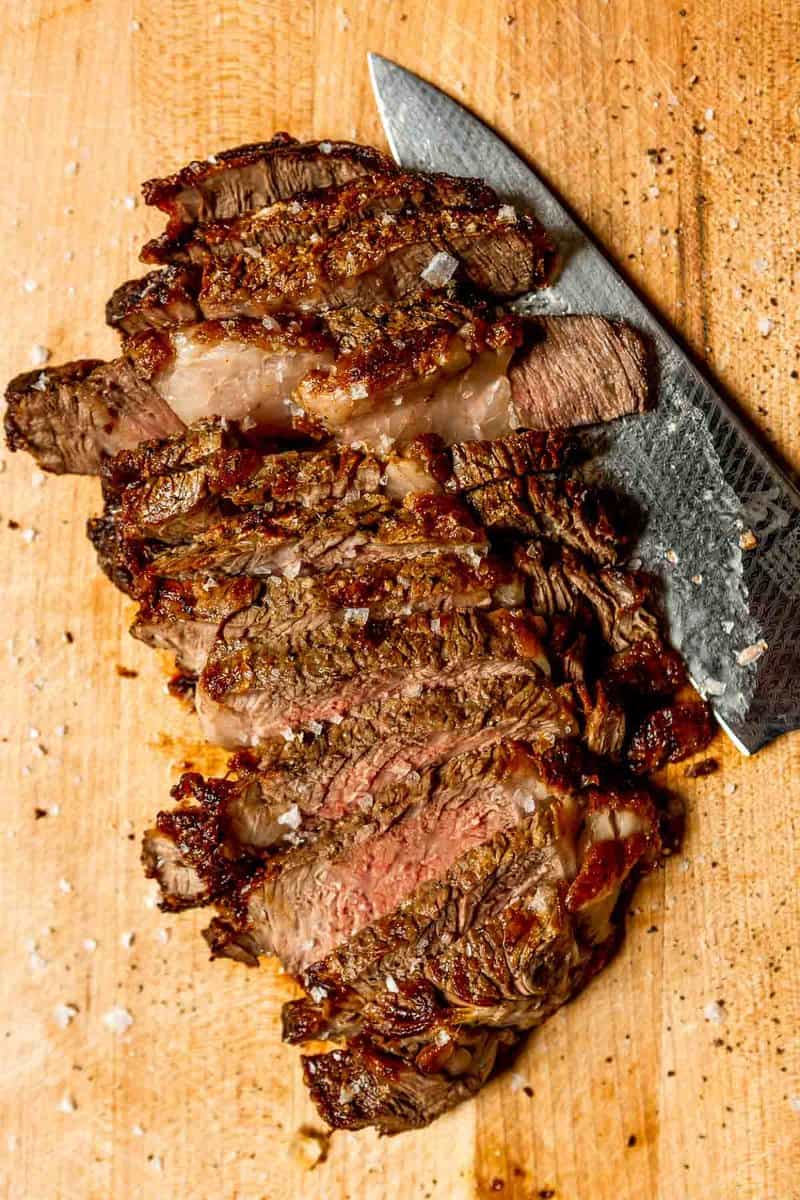
Ribeye Steak FAQs
Ribeye steaks can be bone-in or boneless. If you’re looking for something specific, be sure to ask your butcher or meat counter—even if you don’t see it in the case.
This all depends on the method you are using. If you are grilling over high heat, it will take about 5 minutes per side.
First and foremost, not overcooking your steak is important for creating a juicy steak. Additionally, if you are grilling, pan-searing or roasting the ribeye steak, let it rest before you slice into it. If you slice it too soon after cooking, the flavorful juices will run right out of the steak.
We don’t think it’s necessary to marinate a ribeye steak. Ribeye steaks are incredibly flavorful on their own—one of the reasons this cut is so popular! If you do want to marinate it, keep the mixture simple like smashed garlic, herbs, olive oil, salt and pepper.
The ideal thickness for a ribeye steak is between 1 and 2 inches. Any thicker and your cook times will likely be much longer than specified in a recipe and you risk having an unevenly cooked steak.
There is no “better” or “worse” cut of steak in our opinion. Just different cuts that are better suited for specific cooking methods than others. A ribeye steak is a great option when you simply want to enjoy a juicy steak alongside a side dish or salad. Ribeye steaks are great for reverse searing, sous vide, and grilling.
Skirt steak on the other hand, is an incredibly quick-cooking cut and is perfect for weeknight meals like Steak and Eggs and Tacos al Carbón.
Ribeye steak comes from the rib section of the cow and is a rich, juicy, tender and flavorful cut. It has generous marbling and can be found sold bone-in or boneless. Sirloin on the other hand, also known as top sirloin steak, comes from the sirloin area of the cow (behind the loin and in front of the round). Sirloin steak is a flavorful and juicy cut that’s a bit leaner than ribeye and less marbled.
Steakhouse Sides for Ribeye
Our Garden Salad (which we also refer to as our Steakhouse Salad) is the perfect pairing for a perfectly cooked ribeye. It’s loaded with veggies and just screams side salad.
For a veggie side dish that also dishes up some carbs, make our Orzo Salad studded with crisp-tender asparagus, fresh dill and basil, and loads of Parmesan.
Enjoy something a bit more decadent with our Cauliflower Gratin—it’s great anytime of year but hit differently when the weather starts to turn cool.
Make a super traditional steakhouse meal by pairing a ribeye steak with a classic Caesar Salad.
And finally, every great steak needs a potato salad. Try our caesar Cauliflower Potato Salad or Sour Cream Potato Salad.
More Steak Cooking Guides
Dive into the world of steak with these steak cooking guides!
Learn how to cook Tri-Tip 6 different ways! Then learn how to cut tri-tip (it can be tricky!).
Dive into all things top sirloin and learn how to cook top sirloin 4 different ways!
For something super quick-cooking, learn how to cook a skirt steak. Then serve it as steak and eggs.
If you’ve got leftover steak, be sure you know the best way to reheat steak. Or check out this extensive list of leftover steak recipes.
Ribeye Steak Recipe
Description
Ingredients
- 2 (1–2 inch-thick) ribeye steaks
- Kosher salt and black pepper
Instructions
Grill
- Turn all burners to high, cover, and let grill preheat for about 15 minutes. Brush grill grate clean.
- Pat steak dry with paper towels, then season with 1 teaspoon salt and ½ teaspoon pepper.
- When ready to cook, keep primary burner on high and turn other burners off.
- Place steak over hot part of grill and cook until beginning to char and beads of moisture appear on edges of steak, 5–6 minutes. Flip steak and continue to cook until an instant-read thermometer inserted in the center registers 125ºF for medium-rare, about 5 minutes.
- Transfer steak to a clean plate, tent loosely with foil or parchment paper and let rest 10 minutes.
Oven
- Heat oven to 250ºF with rack set in middle position. Set a wire rack inside a rimmed baking sheet. Pat steaks dry then season generously with kosher salt. Place steaks on rack and roast until an instant-read thermometer inserted into side of steak registers 90ºF–95ºF, this will take 30–50 minutes, flipping the steaks halfway through.
- Heat a generous splash of high-heat cooking oil in a large skillet over high heat until shimmering. Pat steaks dry with paper towels then gently place in skillet and cook, without moving, for 30 seconds. Flip steaks and continue to cook, flipping every 30 seconds, until lightly browned, about 3 minutes.
- Add a few tablespoons of butter to the skillet. Once melted, tilt the skillet so the butter pools; use a large spoon to spoon the butter up and over the steaks repeatedly (this is called basting). Continue to baste steaks, flipping every 30 seconds, until steaks register 120–125ºF for medium-rare, this will take 1–3 minutes.
- Transfer steaks to carving board and let rest for 10 minutes. Strain seasoned butter into small bowl; discard solids. Carve steaks off bones, then slice into ¼-inch-thick slices. Serve with seasoned butter.
Stove Top
- Preheat a large cast-iron skillet over high for 5 minutes.
- Pat steak dry with paper towels, then season with 1 teaspoon salt.
- Reduce heat to medium-high. Add a splash of vegetable oil and swirl to coat the pan. Place steak in skillet. Cook until charred and beads of moisture begin to form around edges of steak, about 3 minutes. Flip and continue cooking until an instant-read thermometer inserted in the center registers 125ºF for medium-rare, about 3 more minutes. For medium cook to an internal temperature is 135ºF, about 4 minutes per side.
- Transfer steak to a clean plate, tent loosely with foil or parchment paper and let rest 10 minutes.
Reverse Sear
- Season steaks all over with salt (at least 1 teaspoon salt per steak).
- Set steaks on a wire rack set inside a rimmed baking sheet. If you have the time, refrigerate steaks, uncovered, at least 2 hours or up to 12 hours. If you don’t have time, skip this step and move on to step 3.
- Heat oven to 200°F (93ºC). (Or as low as your oven goes. If it’s higher than 200ºF the process will take longer).
- Cook steaks in oven until an instant-read thermometer registers 105°F (41°C) for rare, 115°F (46°C) for medium-rare, 125°F (52°C) for medium, or 135°F (57°C) for medium-well. About 20 minutes for rare and up to 40 minutes for medium-well.
- Keep an eye on internal temperature—a lot of factors can impact cooking time.
- About 5 minutes before steaks come out of oven, heat a large cast-iron skillet over high heat until nearly smoking. Once steaks are removed from oven, add 2 tablespoons butter and 2 tablespoons oil to hot skillet; swirling to melt butter and coat skillet.
- Add steaks, garlic, and rosemary (if using) to skillet and cook until each side is well-browned, about 1 ½ minutes per side.
- Using tongs, hold steaks upright on their sides to sear.
- Transfer steaks to a cutting board and let rest 2 minutes. Slice and enjoy immediately.
Air Fry
- Preheat airfryer to 400ºF.
- Pat steak dry with paper towels then season with 1 teaspoon salt.
- Place steak in air fryer basket and cook until browned and an instant read thermometer inserted in the center registers 120–125ºF for medium-rare or 130–135ºF for medium, 8–12 minutes.
- Transfer steak to a plate and tent with foil; let rest 5 minutes.
Sous Vide
- Preheat a sous vide cooker to desired final temperature (we like 129ºF for medium-rare).
- Place in sous vide bags along with herbs and aromatics (optional). Seal bags and place in water bath for 2–3 hours.
- About 5 minutes before removing steak from water bath, start preheating a large cast-iron skillet over high.
- Once the steaks come out of the oven, add a couple tablespoons each butter and oil to the skillet and swirl to coat.
- Sear the steaks, flipping every 15 seconds, until a golden crust is formed on each side and desired doneness is reached, about 1 ½ minutes total. Serve the steak immediately (no need to rest).
Video
Notes
Nutrition
This post is written and created in partnership with the Iowa Beef Council. As always the thoughts, opinions, recipe, photos and content are all my own.
